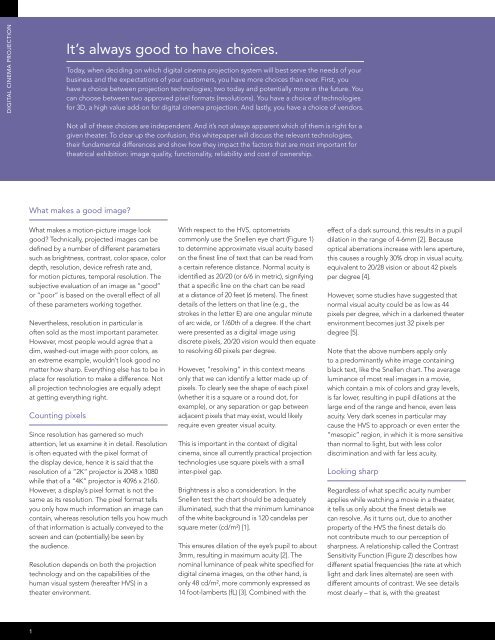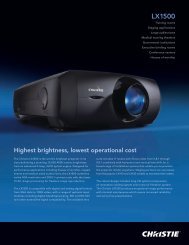Digital cinema projection: choosing the right technology - Christie
Digital cinema projection: choosing the right technology - Christie
Digital cinema projection: choosing the right technology - Christie
You also want an ePaper? Increase the reach of your titles
YUMPU automatically turns print PDFs into web optimized ePapers that Google loves.
<strong>Digital</strong> <strong>cinema</strong> <strong>projection</strong>It’s always good to have choices.Today, when deciding on which digital <strong>cinema</strong> <strong>projection</strong> system will best serve <strong>the</strong> needs of yourbusiness and <strong>the</strong> expectations of your customers, you have more choices than ever. First, youhave a choice between <strong>projection</strong> technologies; two today and potentially more in <strong>the</strong> future. Youcan choose between two approved pixel formats (resolutions). You have a choice of technologiesfor 3D, a high value add-on for digital <strong>cinema</strong> <strong>projection</strong>. And lastly, you have a choice of vendors.Not all of <strong>the</strong>se choices are independent. And it’s not always apparent which of <strong>the</strong>m is <strong>right</strong> for agiven <strong>the</strong>ater. To clear up <strong>the</strong> confusion, this whitepaper will discuss <strong>the</strong> relevant technologies,<strong>the</strong>ir fundamental differences and show how <strong>the</strong>y impact <strong>the</strong> factors that are most important for<strong>the</strong>atrical exhibition: image quality, functionality, reliability and cost of ownership.What makes a good image?What makes a motion-picture image lookgood? Technically, projected images can bedefined by a number of different parameterssuch as b<strong>right</strong>ness, contrast, color space, colordepth, resolution, device refresh rate and,for motion pictures, temporal resolution. Thesubjective evaluation of an image as “good”or “poor” is based on <strong>the</strong> overall effect of allof <strong>the</strong>se parameters working toge<strong>the</strong>r.Never<strong>the</strong>less, resolution in particular isoften sold as <strong>the</strong> most important parameter.However, most people would agree that adim, washed-out image with poor colors, asan extreme example, wouldn’t look good nomatter how sharp. Everything else has to be inplace for resolution to make a difference. Notall <strong>projection</strong> technologies are equally adeptat getting everything <strong>right</strong>.Counting pixelsSince resolution has garnered so muchattention, let us examine it in detail. Resolutionis often equated with <strong>the</strong> pixel format of<strong>the</strong> display device, hence it is said that <strong>the</strong>resolution of a “2K” projector is 2048 x 1080while that of a “4K” projector is 4096 x 2160.However, a display’s pixel format is not <strong>the</strong>same as its resolution. The pixel format tellsyou only how much information an image cancontain, whereas resolution tells you how muchof that information is actually conveyed to <strong>the</strong>screen and can (potentially) be seen by<strong>the</strong> audience.Resolution depends on both <strong>the</strong> <strong>projection</strong><strong>technology</strong> and on <strong>the</strong> capabilities of <strong>the</strong>human visual system (hereafter HVS) in a<strong>the</strong>ater environment.With respect to <strong>the</strong> HVS, optometristscommonly use <strong>the</strong> Snellen eye chart (Figure 1)to determine approximate visual acuity basedon <strong>the</strong> finest line of text that can be read froma certain reference distance. Normal acuity isidentified as 20/20 (or 6/6 in metric), signifyingthat a specific line on <strong>the</strong> chart can be readat a distance of 20 feet (6 meters). The finestdetails of <strong>the</strong> letters on that line (e.g., <strong>the</strong>strokes in <strong>the</strong> letter E) are one angular minuteof arc wide, or 1/60th of a degree. If <strong>the</strong> chartwere presented as a digital image usingdiscrete pixels, 20/20 vision would <strong>the</strong>n equateto resolving 60 pixels per degree.However, “resolving” in this context meansonly that we can identify a letter made up ofpixels. To clearly see <strong>the</strong> shape of each pixel(whe<strong>the</strong>r it is a square or a round dot, forexample), or any separation or gap betweenadjacent pixels that may exist, would likelyrequire even greater visual acuity.This is important in <strong>the</strong> context of digital<strong>cinema</strong>, since all currently practical <strong>projection</strong>technologies use square pixels with a smallinter-pixel gap.B<strong>right</strong>ness is also a consideration. In <strong>the</strong>Snellen test <strong>the</strong> chart should be adequatelyilluminated, such that <strong>the</strong> minimum luminanceof <strong>the</strong> white background is 120 candelas persquare meter (cd/m²) [1].This ensures dilation of <strong>the</strong> eye’s pupil to about3mm, resulting in maximum acuity [2]. Thenominal luminance of peak white specified fordigital <strong>cinema</strong> images, on <strong>the</strong> o<strong>the</strong>r hand, isonly 48 cd/m², more commonly expressed as14 foot-lamberts (fL) [3]. Combined with <strong>the</strong>effect of a dark surround, this results in a pupildilation in <strong>the</strong> range of 4-6mm [2]. Becauseoptical aberrations increase with lens aperture,this causes a roughly 30% drop in visual acuity,equivalent to 20/28 vision or about 42 pixelsper degree [4].However, some studies have suggested thatnormal visual acuity could be as low as 44pixels per degree, which in a darkened <strong>the</strong>aterenvironment becomes just 32 pixels perdegree [5].Note that <strong>the</strong> above numbers apply onlyto a predominantly white image containingblack text, like <strong>the</strong> Snellen chart. The averageluminance of most real images in a movie,which contain a mix of colors and gray levels,is far lower, resulting in pupil dilations at <strong>the</strong>large end of <strong>the</strong> range and hence, even lessacuity. Very dark scenes in particular maycause <strong>the</strong> HVS to approach or even enter <strong>the</strong>“mesopic” region, in which it is more sensitivethan normal to light, but with less colordiscrimination and with far less acuity.Looking sharpRegardless of what specific acuity numberapplies while watching a movie in a <strong>the</strong>ater,it tells us only about <strong>the</strong> finest details wecan resolve. As it turns out, due to ano<strong>the</strong>rproperty of <strong>the</strong> HVS <strong>the</strong> finest details donot contribute much to our perception ofsharpness. A relationship called <strong>the</strong> ContrastSensitivity Function (Figure 2) describes howdifferent spatial frequencies (<strong>the</strong> rate at whichlight and dark lines alternate) are seen withdifferent amounts of contrast. We see detailsmost clearly – that is, with <strong>the</strong> greatest1

















